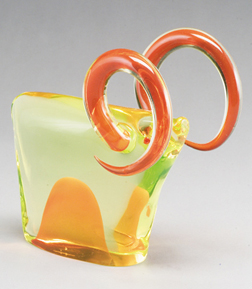
 |
|
Q & A with
Carl Gable,
author of Murano Magic:
Question: Murano Magic has been called "the new definitive reference to Murano." What is different about your approach? Carl: Fundamental to the book, I think, is the conception of Murano and its glassmakers as a unique multi-generational art colony, a swirling anthill of artistic and entrepreneurial families with continual alliances, realliances, reorganizations and metamorphoses. But how do you bring order to an anthill? That's where Murano Magic's organizational system comes into play. First, I trace the major glass firms from their roots, identifying their name changes, the evolution of their artists, artisans and technicians. But then I back off from the firms and turn to the families and individuals. Murano Magic has hundreds of individual profiles and dozens of family trees. For example, there are more than 20 members of the Nason family, more than 50 Tosos; knowing how they are related to each other is a cornerstone to understanding their work. Finally, Murano Magic relates the broad changes in Murano glass styles to innovations in the international art markets and to political and economic change. Of course, the photographs are critical to showing the beauty and evolution of Murano glass. Question: Was it a challenge to assemble the photographs? Carl: Yes, I really underestimated the task. Merely assembling 250 photos is relatively easy; the problem is in assembling a representative variety--not just 250 Veninis and Segusos. But I had wonderful and patient assistance from many knowledgeable dealers, museums, Murano glass producers and collectors around the world. As a result, the illustrations cover a broad spectrum of styles and techniques, and of designers and glassblowers both famous and obscure. And Schiffer's book designer did a spectacular job presenting them all. Question: What distinguishes Murano glass from glass made elsewhere? I mean, how can you tell them apart? Carl: As you would expect, there is no single touchstone that separates Murano glass from glass made elsewhere, or knockoffs and fakes from genuine original items. The ultimate safeguard is knowledge and experience. But there are some features that even novices can be alert to. For example, the formula for Murano glass differs from that in most other glassmaking centers--so in some cases there can be a noticeable difference in the feel of the glass in your hands. Secondly, Murano art glass is notable for a number of complex techniques, which a collector should be on the lookout for as a likely indicator of a Murano source. The techniques pictured and explained in Murano Magic are a good starting point. |
